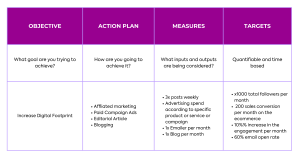Effectively budget for your marketing as a small business.
An easy step-by-step guide for businesses to budget for marketing and how much you should spend on each marketing activities.
This article is for entrepreneurs and small to medium-size business owners who are looking to craft a budget that will produce the desired results and who needs to scale their marketing strategies.
Marketing expenditures can easily increase and have the risk of no difference in your sales or operations, but why do you have to budget for your marketing activities?
Small to medium-size businesses have a different expenditure priorities than an enterprise–for a small business to save on cost as much as you can to cover salaries and essential operational expenditures is more likely to be your number one priority. Marketing expenditures for small businesses vary wildly from month-to-month or yearly. Some small to medium-size businesses believe they’re still small and budgeting for marketing is irrelevant, and only meant for larger organisations who has the cash flow to do so.
The secret to limit immature marketing expenditures is to create a budget according to your marketing plan and activities. A small budget can still provide a success, but one must implement the following early in your business:
- Understand your target audience. Market research, particularly buyer demographics, behaviour and trigger analysis, can help you better understand your target market. Understanding your target audience and their purchasing habits will help you avoid wasting spending on ineffective marketing campaigns.
- Detailed descriptive roadmap of the business plan that sets measures and your goals. A marketing plan should always be aligned with your business goals and passions, for it is important to communicate the right message to the public, which indirectly will increase sales.
- Analysing the competition is also a part of market budgeting. Your opponents will set the industry margins and this might be a clue of how much to dedicate to certain marketing channels and what to abstain from.
- Choose your marketing channels. The marketing channel will depend on the objective, goal, and campaigns.
- Effective reporting and how you will measure its success. Analysing your marketing activities will also indicate what worked and what did not. The lack of monitoring and reporting will lead to mismanagement of your marketing in the future.

To get the best return on your investment (ROI), your budget can ensure your marketing efforts are in line with your business targets.
A marketing budget is used to cover the cost of the team that will execute the marketing plan (marketing team or agency), the cost of marketing messaging (paid ads), the cost of advertisement layout (campaign), and the cost of certain marketing channels (social media etc.).
DETERMINING A MARKETING BUDGET
Establishing a marketing budget can be difficult, particularly if you are unfamiliar with marketing investments and marketing spending can vary significantly depending on sector, location, and the goals of the business.
Your budget ensures that you make smart marketing decisions which line up with your business objectives and will help you determine which campaigns offer the largest return on investment (ROI).
According to 2021 HubSpot Blog Research data 43% of marketers surveyed say their primary goal when running marketing campaigns in 2021 was increasing revenue – making it the second highest goal after brand awareness.
Marketing can play a huge role in increasing revenue as they can target consumers at every stage of the funnel.
How much should you budget for marketing?
To create marketing budgets, businesses apply various strategies, for example:
- Turnover-based: Using turnover to determine your marketing budget. A good percentage to start with is allocating between 5% to 8% of your annual turnover towards your marketing activities.
- Campaign-driven: Campaigns involve management and marketing to initially determine marketing objectives (goals) and afterwards allocating a budget to reach them. For instance, one goal may be to gain increase your digital footprint by creating user driven content and increase sales.
IMPLEMENTING A MARKETING BUDGET
All the above is a “nice” to know, but how do you practically implement your marketing budget?
Let’s break it down in an example.
Here is a marketing budget breakdown on what activities to spend, the percentage of each activity and the reason to spend on these activities.
| Marketing Activity | Description | % of yearly spend | Reason to spend | Occurrence |
| Implementation | ||||
| Marketing Retainer/ Execution | The team who will implement the marketing plan. An honest and good relationship with your marketing team is fundamental. | 20% | Providing a strategic marketing service can be time consuming, but you pay for the experience and knowledge, rather than appointing a whole marketing team internally. | Monthly |
| Marketing Plan | The roadmap of your goals. A marketing plan describes how a business will accomplish a particular goal or mission. | 2% | A marketing plan is fundamental for a small to large businesses, for it gives you a clear understanding of your potential target market and this includes which campaigns, content, channels, and marketing software they’ll use to execute the goal and track its success. | Once-off Annually |
| Website Retainer | Run your website smoothly. It covers maintenance, technical support, updates and bug fixes, and further development of your site. | 9% | This monthly expense is usually neglected, but important for your digital footprint. Being more proactive on your monthly website updates will save you cost in the long run, especially for keeping your website on the latest software version. | Monthly |
| Corporate Branding | ||||
| Branded merchandise | Branded products that have your company’s brand name on them. This includes corporate wear and client gifts. | 5-17% |
Businesses usually spend most of their yearly spend on corporate branding. Although this is a “nice-to-have”, it is not needed each year. Choosing the best quality and making sure your design or items are in line with your Corporate Identity will provide you with more to spend on marketing activities that show higher conversion. Order corporate branding when you employ new staff or every 3 years. |
Ad hoc |
| Signage | It refers to any kind of graphic display intended to convey information to an audience. | Ad hoc | ||
| Stationery | Corporate stationery is not just your official letterhead. It includes all printed documents, like business cards, that bear your business name, logo, slogan, and other details. Every bit of paper or document used for communicating your business. | Ad hoc | ||
| Inbound Marketing | ||||
| Organic social media | Organic social media content is any content shared on social media profiles, including posts, videos, stories, and more. It also entails the creation of posts on different platforms in line with your business goals and passion. | 2-5% | Organic social consistency improves your digital footprint as well is increasing brand awareness. The more you are seen and use the correct keywords, the more your online footprint increases. | Monthly |
| SEO’s and Blogging | SEO stands for “search engine optimization.” In simple terms, SEO means improving your website to increase its visibility on Google. Writing blogs with the correct keywords and backlinks will increase your site | 7% |
Being on top of the Google page takes a lot of traffic to your site, especially if your site is less than a year old. SEO’s helps to bring Organic Search Traffic to your Website, generates leads cost-effectively, increases brand awareness, gets you ahead of the competition, optimises your website for mobile users, and builds trust. Using SEO’s in line with your organic social posting will improve your search ranking faster. |
Monthly |
| Videos |
Video marketing describes the use of video content to promote or inform audiences about your brand and products. Brands can use video across a variety of digital channels and formats. |
15% |
Business owners usually get a shock when they receive the cost of a video. There are 3 aspects to video marketing; video script, filming, or production and editing. Research shows that the average retention rate for videos across the board is 52%. Creating a high-performance video for your marketing campaign can get quite expensive, but the retention rate on a video is much higher than a static image. |
Ad hoc |
| Outbound Marketing: | ||||
|
Print media ads Billboards TV ads Radio ads Events/product launch |
The aim of outbound marketing is to reach as many people as possible, whether they are interested in your product/ service or not. | 10-20% | Although these traditional channels feel ineffective, it is all about reaching as many people as possible. Social media is not the only channel to reach the right audience. Do you fully understand your target market and their purchasing journey map? | Ad hoc |
| Content Creation | ||||
| Design | Creating your logo, branding, and many other design elements to bring your marketing ideas to life. | 5% | The visuals for your campaign can be paid as you need them or per campaign. However, social organic posts will be created monthly and usually in allocated in a marketing retainer. | Ad hoc |
| Advertising: Paid Ads | ||||
| Paid Ads | An online advertising model where advertisers bid to take part in real-time auctions to show their ads within slots on a specific platform or network. | 12-20% | Paid ads can get quite expensive, especially when you must provide high conversion results for new leads. Each social platform differs, and some are more expensive than others. | Monthly |
| Email Marketing | Make your current customers aware of new products, discounts, and other services. It can also be a softer sell to educate your audience on the value of your brand or to keep them engaged between purchases. | 2-5% | Upselling is in your last funnel but fundamental to keeping your current clients interested and providing a competitive edge. Email marketing is very cost-effective and extremely profitable, which makes it one of the best types of digital marketing out there. | Monthly |
HOW CAN HACHOO HELP YOU SAVE AND DO SMART MARKETING WITH A MINIMAL BUDGET?
The number one mistake most small businesses make is when they do not budget, which leads to overspending on marketing activities that could have been prevented through smart budgeting and strategy. With Hachoo we establish a marketing plan, understand your target audience and how they buy, and which channels will benefit you the most.
It is fundamental to develop your well-researched marketing plan to set a clear budget, even if it seems small. If you do not know where to start, contact us and we will help develop your strategic market plan with a smart budget.
FREE Smart Marketing Budget Template
Easy step-by-step guide for businesses to budget for marketing & why to spend on each activity

